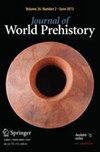吃植物的狗:伊比利亚半岛东北部青铜时代晚期和第一铁器时代犬类饮食的变化
IF 3.1
1区 历史学
Q1 ANTHROPOLOGY
引用次数: 6
摘要
我们研究了来自加泰罗尼亚滨海前洼地(巴塞罗那)Can Roqueta遗址的36只狗(Canis familiaris),其年代介于青铜时代晚期和第一铁器时代(公元前1300年至550年)之间。我们利用27个样本的碳δ13C和氮δ15N同位素组成分析了狗的饮食演变。结果显示,这些天然食肉动物表现出高度以植物为基础的饮食,这明显受到人类的影响。犬科动物和食草有蹄类动物之间的平衡没有达到营养水平的最小值,这意味着C3和C4(谷子)栽培植物的输入。此外,这些数值的同质性表明,狗的食物是人类准备的。本文章由计算机程序翻译,如有差异,请以英文原文为准。
Dogs that Ate Plants: Changes in the Canine Diet During the Late Bronze Age and the First Iron Age in the Northeast Iberian Peninsula
We studied 36 dogs (Canis familiaris) from the Can Roqueta site in the Catalan pre-littoral depression (Barcelona), dated between the Late Bronze Age and the First Iron Age (1300 and 550 cal BC). We used a sample of 27 specimens to analyse the evolution of the dogs’ diet based on the carbon δ13C and nitrogen δ15N isotope composition. The results show a marked human influence in that these natural carnivores display a highly plant-based diet. The offset between canids and herbivorous ungulates does not reach the minimum established for a trophic level, which implies an input of C3 and C4 (millet) cultivated plants. Moreover, the homogeneity in the values indicates that humans prepared their dogs’ food.
求助全文
通过发布文献求助,成功后即可免费获取论文全文。
去求助
来源期刊

Journal of World Prehistory
Multiple-
CiteScore
5.30
自引率
0.00%
发文量
8
期刊介绍:
Aims and scopeJournal of World Prehistory is an international forum for the publication of peer-reviewed, original treatments of the prehistory of an area or larger region. It was founded nearly thirty years ago with the remit of providing researchers, instructors and students with timely and authoritative research syntheses from all fields of archaeology. Journal of World Prehistory continues to lead in this field. Our classic articles may be 20,000 or 25,000 words long, as appropriate (excluding their extensive bibliographies). Since 2008 they have been joined by shorter (around 10,000 words), position pieces, which provide in-depth, thoughtful development of data and concepts, including interventions in controversies that unfold in our pages. These, written in a fashion interesting and accessible to all archaeologists, are often paired with a longer treatment in a single volume. In addition, readers now benefit from thematic special issues and double issues, in which a number of leading authors deal with a key theme in world prehistory, such as the origins of metallurgy (2009, volumes 22: 3 and 4), or the East Asian Neolithic (2013, in preparation). All papers are available first online, followed by the print edition. We aim to be truly global in coverage, with recent articles dealing, inter alia, with Amazonian lithics, the late Jomon of Hokkaido, the Bronze Age in Southeast Asia, the Neanderthal settlement of Doggerland, Neolithic networks in Western Asia, younger Dryas Paleo-Indian adaptations, and state formation in the Horn of Africa. Articles benefit from multi-language abstracts where appropriate, and we work closely with authors who do not have English as a first language to present major syntheses in a clear and concise way to an international audience. Traditionally, JWP focuses on earlier periods, but it includes the beginnings and early development of complex societies, and our understanding of ‘prehistory’ is broad and inclusive: for guidance on chronological scope, as well as our calendrical conventions, see the editorial article ‘Prehistory vs. Archaeology: terms of Engagement’ http://www.springerlink.com/content/346142p032604447/ Our unique remit means that we do not encourage the submission of unsolicited papers; rather, specific proposals are encouraged and then guided prior to independent peer review. Our aims and the way we fulfil them, with close contact with authors throughout the publication process, mean that JWP is not a venue for the simple and rapid dissemination of new results. Whilst we expect scholarship to be current, with syntheses including much new data, our readers look to us for definitive area/period coverage that will have continuing value.If you are proposing an article or special theme for Journal of World Prehistory, please read the Instructions for authors.Rated ''A'' in the European Reference Index for the Humanities (ERIH)?Journal of World Prehistory is rated ''A'' in the ERIH, a new reference index that aims to help evenly access the scientific quality of Humanities research output. For more information visit http://www.esf.org/research-areas/humanities/activities/research-infrastructures.htmlRated ''A'' in the Australian Research Council Humanities and Creative Arts Journal List. For more information, visit: http://www.arc.gov.au/era/journal_list_dev.htm
 求助内容:
求助内容: 应助结果提醒方式:
应助结果提醒方式:


